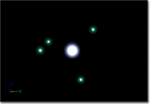Anti-neutrino
Anti-neutrones are a subspecies of neutrino that collectively suffer from manic depressive disorder. It has been found in studies that single anti-neutrinos are only affected mildly by depression, but when larger groups are gathered, or congregate, the depression factor increases exponentially, affecting even larger creatures, such as researchers, scientists, analysts, hulks, mutants, and anyone else that would happen to end up in a research lab or near anti-neutrinos. The depression factor of a single anti-neutrino, though, is enough even to make regular neutrinos active. As it goes against neutrino nature to be active, explosions soon follow, taking out both the neutrino and the anti-neutrino, and often several micrometers of space surrounding them.
Initial discovery[edit | edit source]
Anti-Neutrinos were initially discovered by Irish poet James Joyce in 1903, who stumbled upon a swarm of them, which soon led to his theorizing the existence of quarks, as James went on a drinking binge, suffering from severe depression as a result of exposure to anti-neutrinos.
Research[edit | edit source]
Research on anti-neutrinos was slowed and frequently delayed due to increased drinking problems among researchers and scientists, and eventually the project was scrapped when a distraught Bruce Banner turned green, swelled enormously, wept like a broken child, and flooded the lab, causing major damage to most of the equipment, and drowning several anti-neutrinos, much to the relief of the researchers.
Another lab has begun research on the anti-neutrinos with more success, dosing themselves with large amounts of anti-depressants, and hiring emotionless-ninja assistants.
